What'sNEW April–June 2009
 27 June 2009 27 June 2009
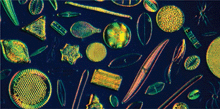 More than 20% of diatom genes were apparently recruited from red and green algae. The process probably began with endosymbiosis, when the algae were engulfed as organelles within cells ancestral to diatoms, but the recruited genes are now incorporated into the diatoms' nuclear genomes. Endosymbiosis is horizontal gene transfer (HGT) in wholesale form, and the subsequent migration of organellar genes into the eukaryotic nucleus is a well known phenomenon. However, other more piecemeal forms of HGT might also account for some of the transferred genes, according to an international research team. Examples of HGT in any form are consistent with evolution by cosmic ancestry.
More than 20% of diatom genes were apparently recruited from red and green algae. The process probably began with endosymbiosis, when the algae were engulfed as organelles within cells ancestral to diatoms, but the recruited genes are now incorporated into the diatoms' nuclear genomes. Endosymbiosis is horizontal gene transfer (HGT) in wholesale form, and the subsequent migration of organellar genes into the eukaryotic nucleus is a well known phenomenon. However, other more piecemeal forms of HGT might also account for some of the transferred genes, according to an international research team. Examples of HGT in any form are consistent with evolution by cosmic ancestry.
 Ahmed Moustafa, Bánk Beszteri et al., "Genomic Footprints of a Cryptic Plastid Endosymbiosis in Diatoms," doi:10.1126/science.1172983, p 1724-1726 v 324, Science, 26 Jun 2009. Ahmed Moustafa, Bánk Beszteri et al., "Genomic Footprints of a Cryptic Plastid Endosymbiosis in Diatoms," doi:10.1126/science.1172983, p 1724-1726 v 324, Science, 26 Jun 2009.
 Tal Dagan and William Martin, "Seeing Green and Red in Diatom Genomes," doi:10.1126/science.1175765, p 1651-1652 v 324, Science, 26 Jun 2009. Tal Dagan and William Martin, "Seeing Green and Red in Diatom Genomes," doi:10.1126/science.1175765, p 1651-1652 v 324, Science, 26 Jun 2009.
 Viruses and Other Gene Transfer Mechanisms is the main webpage about HGT. [ Viruses and Other Gene Transfer Mechanisms is the main webpage about HGT. [ What'sNEW about HGT What'sNEW about HGT  ] ]

A bacterial mat covering a brine pool on a deep-sea mud volcano in the Mediterranean |
 20 June 2009 20 June 2009
...Some microbes thrive at ...10 times the salinity of seawater.
 Antje Boetius and Samantha Joye, "Thriving in Salt," doi:10.1126/science.1172979, p 1523-1525 v 324, Science, 19 Jun 2009. Antje Boetius and Samantha Joye, "Thriving in Salt," doi:10.1126/science.1172979, p 1523-1525 v 324, Science, 19 Jun 2009.
 Johanna Laybourn-Parry, "No Place Too Cold," doi:10.1126/science.1173645, p 1521-1522 v 324, Science, 19 Jun 2009. Johanna Laybourn-Parry, "No Place Too Cold," doi:10.1126/science.1173645, p 1521-1522 v 324, Science, 19 Jun 2009.
 Bacteria: The Space Colonists is a related webpage. Bacteria: The Space Colonists is a related webpage.
 20 June 2009 20 June 2009
The tree of life was always a net. Nature was always a genetic engineer.
 Stefan Helmreich, Alien Ocean: anthropological voyages on microbial seas, ISBN-10: 0520250613, University of California Press, 5 Jan 2009. (p 103) Stefan Helmreich, Alien Ocean: anthropological voyages on microbial seas, ISBN-10: 0520250613, University of California Press, 5 Jan 2009. (p 103)
 The Tree of Life is a related webpage. The Tree of Life is a related webpage.
 15 June 2009 15 June 2009
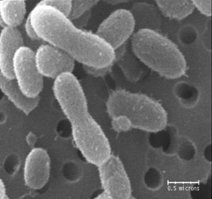 A novel bacterium that has been trapped more than three kilometres under glacial ice in Greenland for over 120,000 years, may hold clues as to what life forms might exist on other planets. This is what astrobiologists are saying about Herminiimonas glaciei, recently found and cultured by a team at Penn State. The bacteria are small enough to pass through a normal sterilizing filter, and culturing them was tedious. But could their hardiness enable them to survive on a place like Europa? These extremely cold environments are the best analogues of possible extraterrestrial habitats, said team leader Jennifer Loveland-Curtze.
A novel bacterium that has been trapped more than three kilometres under glacial ice in Greenland for over 120,000 years, may hold clues as to what life forms might exist on other planets. This is what astrobiologists are saying about Herminiimonas glaciei, recently found and cultured by a team at Penn State. The bacteria are small enough to pass through a normal sterilizing filter, and culturing them was tedious. But could their hardiness enable them to survive on a place like Europa? These extremely cold environments are the best analogues of possible extraterrestrial habitats, said team leader Jennifer Loveland-Curtze.
 Jennifer Loveland-Curtze et al., "Herminiimonas glaciei sp. nov., a novel ultramicrobacterium from 3042 m deep Greenland glacial ice," doi:10.1099/ijs.0.001685-0, p 1272-1277 v 59, International Journal of Systematic and Evolutionary Microbiology, Jun 2009. Jennifer Loveland-Curtze et al., "Herminiimonas glaciei sp. nov., a novel ultramicrobacterium from 3042 m deep Greenland glacial ice," doi:10.1099/ijs.0.001685-0, p 1272-1277 v 59, International Journal of Systematic and Evolutionary Microbiology, Jun 2009.
 A Survivor in Greenland: A Novel Bacterial Species is Found Trapped in 120,000-Year-Old Ice, Penn State University, 3 Jun 2009. A Survivor in Greenland: A Novel Bacterial Species is Found Trapped in 120,000-Year-Old Ice, Penn State University, 3 Jun 2009.
 A tiny frozen microbe may hold clues to extraterrestrial life, EurekAlert!, 14 Jun 2009. A tiny frozen microbe may hold clues to extraterrestrial life, EurekAlert!, 14 Jun 2009.
 Bacteria: The Space Colonists is a related webpage. Bacteria: The Space Colonists is a related webpage.
 Life on Europa, Other Moons, Other Planets? is a webpage with links to related articles. Life on Europa, Other Moons, Other Planets? is a webpage with links to related articles.

 10 June 2009 10 June 2009
...Metabolically active microbes were reported in 111-million-year-old sediments buried as deep as 1.6 kilometres below the seabed. This is among the surprises in a recent article about prokaryotes that can survive in harsh deep environments. Some of them may reproduce only once per thousand years. Some can persist solely on energy that comes from radioactivity. Astrobiologists are wondering why they couldn't live on other planets. We think they probably could.
 Amanda Leigh Mascarelli, "Geomicrobiology: Low life" [html], doi:10.1038/459770a, p 770-773 v 459, Nature, online 10 June 2009. Amanda Leigh Mascarelli, "Geomicrobiology: Low life" [html], doi:10.1038/459770a, p 770-773 v 459, Nature, online 10 June 2009.
 Bacteria: The Space Colonists is a related webpage. Bacteria: The Space Colonists is a related webpage.
 9 June 2009 9 June 2009
 Formic acid ...has been found at record levels on a meteorite that fell onto a frozen Canadian lake in 2000. The University of Alberta's meteorite curator Chris Herd (pictured with sample) reported this finding to the American Geophysical Union in Toronto in May. The Tagish Lake meteorite is an especially pristine one; organic compounds in it are unlikely to be earthly contaminants. Organics from space are usually called "prebiotic", but we think they could as well be "postbiotic".
Formic acid ...has been found at record levels on a meteorite that fell onto a frozen Canadian lake in 2000. The University of Alberta's meteorite curator Chris Herd (pictured with sample) reported this finding to the American Geophysical Union in Toronto in May. The Tagish Lake meteorite is an especially pristine one; organic compounds in it are unlikely to be earthly contaminants. Organics from space are usually called "prebiotic", but we think they could as well be "postbiotic".
 Space rock yields answers about origins of life on Earth by Wanda Vivequin, University of Alberta, 2 Jun 2009. Space rock yields answers about origins of life on Earth by Wanda Vivequin, University of Alberta, 2 Jun 2009.
 Comets... is a related webpage with more about the Tagish Lake meteorite. Comets... is a related webpage with more about the Tagish Lake meteorite.
 Thanks, Stan Franklin. Thanks, Stan Franklin.
 6 June 2009 6 June 2009
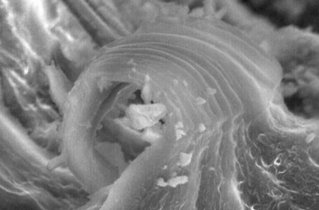 Astrobiologist Richard Hoover discusses his work in a new short video. In five minutes he describes extremophiles that could apparently survive in ice on Mars or Europa, and microfossils that resemble microbial life, found inside carbonaceous meteorites (see example). One microfossil in the Murchison meteorite was seen for the first time as the video was being filmed.
Astrobiologist Richard Hoover discusses his work in a new short video. In five minutes he describes extremophiles that could apparently survive in ice on Mars or Europa, and microfossils that resemble microbial life, found inside carbonaceous meteorites (see example). One microfossil in the Murchison meteorite was seen for the first time as the video was being filmed.
 Extremophile Hunter, narrated by Bruce Burkhardt, produced by Kate Tobin for the National Science Foundation's online magazine Science Nation, 1 Jun 2009. Extremophile Hunter, narrated by Bruce Burkhardt, produced by Kate Tobin for the National Science Foundation's online magazine Science Nation, 1 Jun 2009.
 Fossilized Life Forms in the Murchison Meteorite is a related webpage. Fossilized Life Forms in the Murchison Meteorite is a related webpage.
 Evidence for Indigenous Microfossils in a Carbonaceous Meteorite is a related webpage. Evidence for Indigenous Microfossils in a Carbonaceous Meteorite is a related webpage.
 5 June 2009 5 June 2009
The enemy has become more diverse, says anthropologist Eugenie Scott, executive director of the National Center for Science Education. "Darwin's golden retriever," as she likes to be known, Scott was recently interviewed for Science magazine. In the quoted phrase she may be acknowledging the fact that some who see problems with the mainstream theory of evolution have no agenda beyond science. But she categorizes them all as "the enemy," keeping the discussion strongly polarized and superficial. This tactic impedes scientific progress.

The mainstream theory of evolution has no credible acount of the origin of life, certainly. Acknowledging this, Scott stubbornly says, "Not yet." Alchemists trying to turn lead into gold said the same thing. Also unexplained are the genetic programs contained within DNA. Darwinan mutation-and-natural-selection is supposed to compose them, but direct evidence for this composing is lacking. Instead, darwinan mutation-and-natural-selection can be seen only to toggle, shuffle and optimize programs that are already present in a given genome. New genetic programs often appear suddenly during evolution; many are known to arrive by gene transfer (HGT). But Scott would minimize the importance of HGT and assert that evidence for the mainstream account of new genetic programs is abundant. In a similar manner, Galileo's opponents held that Ptolemaic astronomy was perfectly adequate. Given the described shortcomings, it is no surprise that a majority of Americans are not satisfied with the mainstream theory of evolution. Apparently, the National Center for Science Education sees a majority of Americans as "the enemy." Such animosity from the science establishment is unwarranted and, to our knowledge, unprecedented.

 Yudhijit Bhattacharjee, "Eugenie Scott Toils in Defense of Evolution" [html], doi:10.1126/science.324_1250b, p 1250-1251 v 324, Science, 5 Jun 2009. Yudhijit Bhattacharjee, "Eugenie Scott Toils in Defense of Evolution" [html], doi:10.1126/science.324_1250b, p 1250-1251 v 324, Science, 5 Jun 2009.
 Comparing Darwinism, Creationism/ID and Cosmic Ancestry is a related webpage. Comparing Darwinism, Creationism/ID and Cosmic Ancestry is a related webpage.
 Evolution vs Creationism is a related webpage. Evolution vs Creationism is a related webpage.
 ...A Third Alternative, by Klyce and Wickramasinghe, is a related reprint. ...A Third Alternative, by Klyce and Wickramasinghe, is a related reprint.
 Testing Darwinism versus Cosmic Ancestry is a related webpage. Testing Darwinism versus Cosmic Ancestry is a related webpage.
 30 May 2009 30 May 2009
For prokaryotes, entire metabolic pathways from this universal network could be added by the virtue of horizontal gene transfer (HGT)....
 Sergei Maslov et al., "Toolbox model of evolution of prokaryotic metabolic networks and their regulation" [abstract], doi:10.1073/pnas.0903206106, Proc. Natl Acad. Sci. USA, online 29 May 2009. Sergei Maslov et al., "Toolbox model of evolution of prokaryotic metabolic networks and their regulation" [abstract], doi:10.1073/pnas.0903206106, Proc. Natl Acad. Sci. USA, online 29 May 2009.
 Viruses and Other Gene Transfer Mechanisms is the main related webpage [ Viruses and Other Gene Transfer Mechanisms is the main related webpage [ What'sNEW about HGT What'sNEW about HGT  ] ]
 28 May 2009 28 May 2009
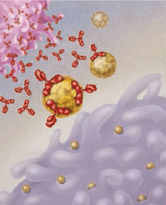 In what has been called the "big bang of immunology," most vertebrates later evolved a second form of immunity, in which white blood cells exquisitely targeted to a specific pathogen are rallied and then maintained in the body as an immune memory. This "adaptive" arm seemed to have appeared out of nowhere some 450 million years ago and may be the serendipitous outcome of invading DNA introduced by a virus or microbe infecting a fishlike creature.
In what has been called the "big bang of immunology," most vertebrates later evolved a second form of immunity, in which white blood cells exquisitely targeted to a specific pathogen are rallied and then maintained in the body as an immune memory. This "adaptive" arm seemed to have appeared out of nowhere some 450 million years ago and may be the serendipitous outcome of invading DNA introduced by a virus or microbe infecting a fishlike creature.
...In 1995, Craig Thompson, then at the University of Chicago in Illinois, formally proposed that the DNA now encoding RAG1 and RAG2 was once a mobile genetic element called a transposon. ...In 2006, a team led by Jonathan Rast of the University of Toronto in Canada and Sebastian Fugmann of the National Institute on Aging in Bethesda, Maryland, analyzed the genome of the purple sea urchin and found genes that closely resemble RAG1 and RAG2, the first time they've been uncovered in invertebrates.
In cosmic ancestry, evolutionary innovations depend on genetic programs acquired by various means of horizontal gene transfer (HGT). These programs must necessarily reside silently somewhere before they arrive in species that can use them. The programs would need a means of transfer such as viral or bacterial infection. And they would need tools and systems within the acquiring genome to place and assemble them correctly. Of course, every element of this scenario is already well observed. If evolutionary innovations emerge as cosmic ancestry predicts, the immune system of jawed vertebrates makes a striking example.
| The lamprey's alternative immune system by John Travis, Origins blog, 28 May 2009. ...A whole set of evolutionary questions arises as to how completely different diversifying receptor proteins were inserted into the jawed and jawless systems. |
 John Travis, "On the Origin of The Immune System," doi:10.1126/science.324_580, p 580-582 v 324, Science, 1 May 2009. John Travis, "On the Origin of The Immune System," doi:10.1126/science.324_580, p 580-582 v 324, Science, 1 May 2009.
 Only a Theory: book review with related discussion, 4 Nov 2008. Only a Theory: book review with related discussion, 4 Nov 2008.
 We owe the repertoire of our immune system to one transposon insertion...., What'sNEW, 25 Aug 1998. We owe the repertoire of our immune system to one transposon insertion...., What'sNEW, 25 Aug 1998.
 Viruses and Other Gene Transfer Mechanisms is the main related webpage [ Viruses and Other Gene Transfer Mechanisms is the main related webpage [ What'sNEW about HGT What'sNEW about HGT  ] ]
 22 May 2009 22 May 2009
You don't necessarily need to have a lot of water to have life, but you need liquid water at some point — Vincent F. Chevrier, Arkansas Center for Space and Planetary Sciences. Chevrier's team showed that conditions at the Phoenix landing site on Mars would allow liquid water to persist for "a few hours each day during the summer."
 Research Demonstrates Potential for Liquid Water on Present-Day Mars, University of Arkansas, 21 May 2009. Research Demonstrates Potential for Liquid Water on Present-Day Mars, University of Arkansas, 21 May 2009.
 Life on Mars! is a related webpage. Life on Mars! is a related webpage.
And an international team proposes that dissolved minerals can explain saline liquid water activity on the surface of Mars at mean global temperatures well below 273 K.
 Alberto G. Fairén et al., "Stability against freezing of aqueous solutions on early Mars" [abstract], doi:10.1038/nature07978, p 401-404 v 459, Nature, 21 May 2009. Alberto G. Fairén et al., "Stability against freezing of aqueous solutions on early Mars" [abstract], doi:10.1038/nature07978, p 401-404 v 459, Nature, 21 May 2009.
 Martian Water Had Antifreeze by Phil Berardelli, ScienceNOW Daily News, 20 May 2009. Martian Water Had Antifreeze by Phil Berardelli, ScienceNOW Daily News, 20 May 2009.
 Chilly brine could have harboured life on Mars by Ivan Semeniuk, NewScientist, 20 May 2009. Chilly brine could have harboured life on Mars by Ivan Semeniuk, NewScientist, 20 May 2009.
 Liquid water on Phoenix lander's leg? is a related What'sNEW article, 18 Feb 2009. Liquid water on Phoenix lander's leg? is a related What'sNEW article, 18 Feb 2009.
 18 May 2009 18 May 2009
Viral infections can augment the metabolism, immunity, distribution and evolution of their hosts in many unexpected and potentially positive ways.
 Forest Rohwer and Rebecca Vega Thurber, "Viruses manipulate the marine environment" [abstract], doi:10.1038/nature08060, p 207-212 v 459, Nature, 14 May 2009. Forest Rohwer and Rebecca Vega Thurber, "Viruses manipulate the marine environment" [abstract], doi:10.1038/nature08060, p 207-212 v 459, Nature, 14 May 2009.
 Viruses and Other Gene Transfer Mechanisms is the main related webpage [ Viruses and Other Gene Transfer Mechanisms is the main related webpage [ What'sNEW about HGT What'sNEW about HGT  ] ]
 13 May 2009 13 May 2009
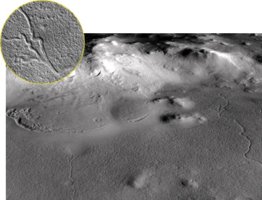 Rivers flowed on Mars more recently than once believed. To ascertain this a team at Brown University studied high-resolution images of the Lyot crater taken by the Mars Reconnaissance Orbiter. Although it was formed only about a billion years ago, the crater contains river channels up to 50 km long. The crater floor is 7,000 meters deep, so surface air pressure would likely have been high enough for meltwater from underground glaciers to persist in a liquid state. Liquid water would have allowed life to grow on Mars.
Rivers flowed on Mars more recently than once believed. To ascertain this a team at Brown University studied high-resolution images of the Lyot crater taken by the Mars Reconnaissance Orbiter. Although it was formed only about a billion years ago, the crater contains river channels up to 50 km long. The crater floor is 7,000 meters deep, so surface air pressure would likely have been high enough for meltwater from underground glaciers to persist in a liquid state. Liquid water would have allowed life to grow on Mars.
 J. L. Dickson et al., "Amazonian-aged fluvial valley systems in a climatic microenvironment on Mars: Melting of ice deposits on the interior of Lyot Crater," doi:10.1029/2009GL037472, L08201 v 36, Geophysical Research Letters, 17 Apr 2009. J. L. Dickson et al., "Amazonian-aged fluvial valley systems in a climatic microenvironment on Mars: Melting of ice deposits on the interior of Lyot Crater," doi:10.1029/2009GL037472, L08201 v 36, Geophysical Research Letters, 17 Apr 2009.
 Recent Rivers on the Red Planet, by Jackie Grom, ScienceNOW Daily News, 12 May 2009. Recent Rivers on the Red Planet, by Jackie Grom, ScienceNOW Daily News, 12 May 2009.
 Life on Mars! is a related webpage. Life on Mars! is a related webpage.
| | scale bar = 100 nanometers |
 6 May 2009 6 May 2009
...The existence of a unique vertex in Mimivirus, possibly for genome delivery, is reminiscent of tailed bacteriophages. ...Implying that Mimiviruses and some other large icosahedral dsDNA viruses have gathered genes from eukaryotic, prokaryotic, as well as archaeal origins.
 Xiao C, Kuznetsov YG, Sun S, Hafenstein SL, Kostyuchenko VA, et al., "Structural Studies of the Giant Mimivirus" [article], doi:10.1371/journal.pbio.1000092, v7 n4 e92, PLoS Biology, 28 Apr 2009. Xiao C, Kuznetsov YG, Sun S, Hafenstein SL, Kostyuchenko VA, et al., "Structural Studies of the Giant Mimivirus" [article], doi:10.1371/journal.pbio.1000092, v7 n4 e92, PLoS Biology, 28 Apr 2009.
 Viruses and Other Gene Transfer Mechanisms is the main related webpage [ Viruses and Other Gene Transfer Mechanisms is the main related webpage [ What'sNEW about HGT What'sNEW about HGT  ] ]
 6 May 2009 6 May 2009
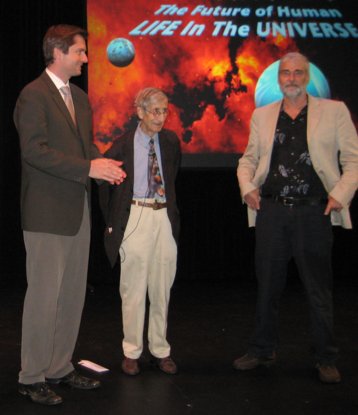 Freeman Dyson thinks panspermia is more likely if life can adapt to the vacuum of space. In Cambridge MA on May 2, he went on to say that we should look for forms of extraterrestrial life that are easiest to find, not ones that we consider most likely to exist. For example, plant-like life on the surface of a dimly lit planet or moon would need a light-concentrating aparatus such as a parabolic mirror or a lens. Such life would shine brightly when viewed from the direction of its source, like a deer's eyes in the headlights, suggested Dyson (pictured, center).
Freeman Dyson thinks panspermia is more likely if life can adapt to the vacuum of space. In Cambridge MA on May 2, he went on to say that we should look for forms of extraterrestrial life that are easiest to find, not ones that we consider most likely to exist. For example, plant-like life on the surface of a dimly lit planet or moon would need a light-concentrating aparatus such as a parabolic mirror or a lens. Such life would shine brightly when viewed from the direction of its source, like a deer's eyes in the headlights, suggested Dyson (pictured, center).
A renowned physicist, Dyson was among nine distnguished scientists who spoke at a two-day public symposium sponsored by The Harvard-Smithsonian Center for Astrophysics and The Harvard Origins of Life Initiative, held during the Cambridge Science Festival. Others speakers included Harvard Astronomy Professor David Charbonneau (left), and University of Washington paleontologist Peter Ward (right). Panspermia was favorably mentioned by several of the speakers, including Dimitar Sasselov, who heads the Harvard Origins Initiative. Because impacts can launch life-bearing material into space, he said, "Panspermia is the future of the galaxy."
 Crossroads: The Future of Human Life In The Universe Conference moderated by David Aguilar, 30 Apr - 2 May 2009. Crossroads: The Future of Human Life In The Universe Conference moderated by David Aguilar, 30 Apr - 2 May 2009.
 Life in the universe? Almost certainly. Intelligence? Maybe not by Alvin Powell, Physorg.com, 12 May 2009. Life in the universe? Almost certainly. Intelligence? Maybe not by Alvin Powell, Physorg.com, 12 May 2009.
 Could flowers bloom on icy moon Europa? by Rachel Courtland, NewScientist, 5 May 2009. Could flowers bloom on icy moon Europa? by Rachel Courtland, NewScientist, 5 May 2009.
 The Sense of Wonder at the Crossroads by Roald Maravillas, Exoplanetology, 7 May 2009. The Sense of Wonder at the Crossroads by Roald Maravillas, Exoplanetology, 7 May 2009.
 Introduction: More Than Panspermia is a related webpage. Introduction: More Than Panspermia is a related webpage.
 Thanks for alerting us to this symposium, Larry Klaes, Google Alerts and Stan Franklin. Thanks for alerting us to this symposium, Larry Klaes, Google Alerts and Stan Franklin.
 28 April 2009 28 April 2009
Life is nothing but an electron looking for a place to rest — Albert Szent-Gyorgi. This definition of life is endorsed by two professors from George Mason University and one at the Santa Fe Institute. Their origin-of-life proposal is a version categorized as Metabolism First. They say this concept is better than the RNA World theory because:
Inserting RNA molecules into an RNA First scenario without explaining how they got there seems to us an inadequate foundation for an origin theory. The RNA molecule is too complex, requiring assembly first of the monomeric constituents of RNA, then assembly of strings of monomers into polymers. As a random event without a highly structured chemical context, this sequence has a forbiddingly low probability and the process lacks a plausible chemical explanation, despite considerable effort to supply one.
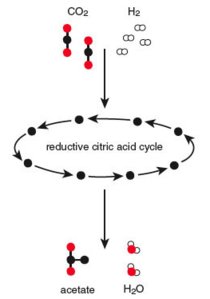 In their Metabolism-First scenario a simplified version of the Krebs cycle originally ran backward, using carbon dioxide and hydrogen to produce water and acetate (right). They believe that this cycle could arise naturally, and could acquire "further elaborations" enabling it to produce more complex organic molecules. Hopefully, a way to exclude the harmful byproducts will become apparent, they note. Later the system could come under the control of RNA molecules and begin to resemble life as we know it. They suggest that, this way, "the early stages in the emergence of life are no more surprising, no more accidental, than water flowing downhill."
In their Metabolism-First scenario a simplified version of the Krebs cycle originally ran backward, using carbon dioxide and hydrogen to produce water and acetate (right). They believe that this cycle could arise naturally, and could acquire "further elaborations" enabling it to produce more complex organic molecules. Hopefully, a way to exclude the harmful byproducts will become apparent, they note. Later the system could come under the control of RNA molecules and begin to resemble life as we know it. They suggest that, this way, "the early stages in the emergence of life are no more surprising, no more accidental, than water flowing downhill."
The hope is that when a full theory is available, we will see the formation of life as an inevitable outcome of basic thermodynamics, like the freezing of ice cubes or the formation of magnets.
We admire the optimism and imagination of origin-of-life theorists, but we have questions:
- How many of the required steps can be demonstrated in realistic experiments?
- How likely is it that all the steps will occur in proper sequence in a natural environment?
- If metabolism comes first, how does it later fall under the control of a genetic system?
- How does the genetic system acquire its programming (software)?
- Life on Earth could come from space. The big bang is incompletely understood. The origin of life has never been witnessed, only assumed to occur. Why do origin-of-life theories get so much attention?
 James Trefil, Harold Morowitz and Eric Smith, "The Origin of Life," doi:10.1511/2009.78.206, American Scientist, Mar-Apr 2009. James Trefil, Harold Morowitz and Eric Smith, "The Origin of Life," doi:10.1511/2009.78.206, American Scientist, Mar-Apr 2009.
 What Is Life? is a related local webpage. What Is Life? is a related local webpage.
 The RNA World is our main webpage about origin-of-life theories. The RNA World is our main webpage about origin-of-life theories.
 The Second Law of Thermodynamics is a related local webpage. The Second Law of Thermodynamics is a related local webpage.
 Thanks, Stan Franklin. Thanks, Stan Franklin.
 23 April 2009 23 April 2009
It's hard to imagine a planet's surface exhibiting handedness without the presence of self assembly, which is an essential component of life — Thom Germer, physicist, the National Institute of Standards and Technology. A team at NIST is working on a system for detecting life on other planets by looking at the light reflected from their surfaces. If the light exhibits a biased circular polarity, it is probably coming from living surfaces, they believe. They think this signal would be present even if the life there is chemically unlike Earthly life.
Chirality has already been studied in carbonaceous meteorites. In a recent study of six of them, all six contained amino acids that were predominantly left-handed, like Earthly life. We think NIST's logic for planets should apply to meteorites as well. The chiralty observed in them is easily understood if their parent bodies once harbored Earth-like life whose amino acid remnants still bear traces of left-handedness.
 William Sparks et al., "Detection of circular polarization in light scattered from photosynthetic microbes" [Open Access abstract], doi:10.1073/pnas.0810215106, Proc. Natl Acad. Sci. USA, online 28 Apr 2009. William Sparks et al., "Detection of circular polarization in light scattered from photosynthetic microbes" [Open Access abstract], doi:10.1073/pnas.0810215106, Proc. Natl Acad. Sci. USA, online 28 Apr 2009.

 Scientists Give a Hand(edness) to the Search for Alien Life by Chad Boutin, NIST, 21 Apr 2009. Scientists Give a Hand(edness) to the Search for Alien Life by Chad Boutin, NIST, 21 Apr 2009.
 A circular argument? by Phillip Ball, doi:10.1038/news.2009.390, NatureNews, 24 Apr 2009. A circular argument? by Phillip Ball, doi:10.1038/news.2009.390, NatureNews, 24 Apr 2009.
 Predominantly left-handed amino acids were found in six out of six meteorites..., What'sNEW, 17 Mar 2009. Predominantly left-handed amino acids were found in six out of six meteorites..., What'sNEW, 17 Mar 2009.
 Amino Acid Asymmetry in the Murchison Meteorite! is the main related webpage. Amino Acid Asymmetry in the Murchison Meteorite! is the main related webpage.
 22 April 2009 22 April 2009
 An interview with James Lovelock, the inventor of Gaia theory, is available on the Internet.
An interview with James Lovelock, the inventor of Gaia theory, is available on the Internet.
 Streaming video: Lovelock, Nature Publishing Group, +YouTube, 2009. Streaming video: Lovelock, Nature Publishing Group, +YouTube, 2009.
 Andrew Watson, "Final warning from a sceptical prophet" (reviews of a book by James Lovelock, and a book about him) [html], doi:10.1038/458970a, p 970-971 v 458, Nature, 23 Apr 2009. Andrew Watson, "Final warning from a sceptical prophet" (reviews of a book by James Lovelock, and a book about him) [html], doi:10.1038/458970a, p 970-971 v 458, Nature, 23 Apr 2009.
 Gaia is a related webpage. Gaia is a related webpage.
 22 April 2009 22 April 2009
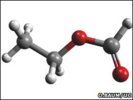 Two new complex organic molecules have been seen toward the center of our galaxy. Ethyl formate (right) and n-propyl cyanide were detected by astronomers analysing spectra gathered at the 30-meter IRAM telescope in southern Spain.
Two new complex organic molecules have been seen toward the center of our galaxy. Ethyl formate (right) and n-propyl cyanide were detected by astronomers analysing spectra gathered at the 30-meter IRAM telescope in southern Spain. Complex organic molecules were once thought to come from only biological processes, so finding them in space, beginning in the 1960s, was a surprise. Now more than a hundred different ones have been observed, and nonbiological processes to explain them are being proposed. We think biological processes should be considered. Life is far more efficient than nonlife at making organic molecules.
 R. Garrod et al., "First Detections of Interstellar Ethyl Formate and NPropyl Cyanide: Dust-Grain Chemistry Strikes Again," presented at The European Week of Astronomy & Space Science, University of Hertfordshire, UK, 21 Apr 2009. R. Garrod et al., "First Detections of Interstellar Ethyl Formate and NPropyl Cyanide: Dust-Grain Chemistry Strikes Again," presented at The European Week of Astronomy & Space Science, University of Hertfordshire, UK, 21 Apr 2009.
 Complex molecules seen in space by Paul Rincon, BBC News, 21 Apr 2009. Complex molecules seen in space by Paul Rincon, BBC News, 21 Apr 2009.
 Hoyle and Wickramasinghe's Analysis of Interstellar Dust is a related webpage. Hoyle and Wickramasinghe's Analysis of Interstellar Dust is a related webpage.
 Thanks, Stan Franklin. Thanks, Stan Franklin.
 17 April 2009 17 April 2009
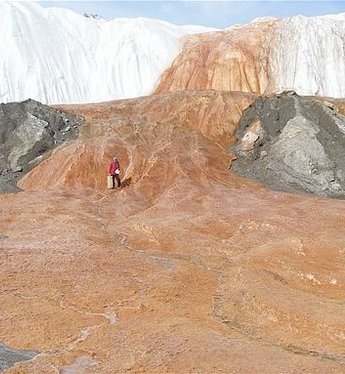 Microbial life trapped in darkness under ice accounts for the "Blood Falls" at the snout of Taylor Glacier in Antarctica. An international interdisciplinary team shows that the staining brine leaks from a hidden pool of iron-rich, oxygen-poor, hyper-saline seawater. The pool was trapped some 1.5 to 4 million years ago when the glacier closed over it. To account for the chemicals and isotope ratios observed in the discharge, the team proposes that a metabolically active ecosystem, with microbes converting ferric iron to ferrous iron, creates food and energy in the pool. When the brine episodically leaks onto the surface 4 km away, the ferrous iron "rusts" and turns red.
Microbial life trapped in darkness under ice accounts for the "Blood Falls" at the snout of Taylor Glacier in Antarctica. An international interdisciplinary team shows that the staining brine leaks from a hidden pool of iron-rich, oxygen-poor, hyper-saline seawater. The pool was trapped some 1.5 to 4 million years ago when the glacier closed over it. To account for the chemicals and isotope ratios observed in the discharge, the team proposes that a metabolically active ecosystem, with microbes converting ferric iron to ferrous iron, creates food and energy in the pool. When the brine episodically leaks onto the surface 4 km away, the ferrous iron "rusts" and turns red.
DNA analysis reveals that the pool contains species similar to known marine microorganisms, but they must be ones that can survive "without the food and light sources available in the open ocean." By logic, the genetic programs enabling the necessary new metabolic processes must have become effective promptly when food and light were sealed out by the glacier. Otherwise — even if the various species could remain viable by going dormant — metabolism and evolution would cease. Their prompt availability suggests to us that the programs were pre-existing.
The research team wonders if similar life could survive, "perhaps even on other icy planets in the solar system such as below the Martian ice caps or in the ice-covered oceans of Jupiter's moon Europa." Why not?
 Jill A. Mikucki et al., "A Contemporary Microbially Maintained Subglacial Ferrous 'Ocean'" [link], doi:10.1126/science.1167350, p 397-400 v 324, Science, 17 Apr 2009. Jill A. Mikucki et al., "A Contemporary Microbially Maintained Subglacial Ferrous 'Ocean'" [link], doi:10.1126/science.1167350, p 397-400 v 324, Science, 17 Apr 2009.
 Jill A. Mikucki and John C. Priscu, "Bacterial Diversity Associated with Blood Falls, a Subglacial Outflow from the Taylor Glacier, Antarctica" [abstract], doi:10.1128/AEM.01396-06, p 4029-4039, v 73, Applied and Environmental Microbiology, Jun 2007. Jill A. Mikucki and John C. Priscu, "Bacterial Diversity Associated with Blood Falls, a Subglacial Outflow from the Taylor Glacier, Antarctica" [abstract], doi:10.1128/AEM.01396-06, p 4029-4039, v 73, Applied and Environmental Microbiology, Jun 2007.
 J.A. Mikucki and J.C. Priscu, "Microbial Life in Blood Falls: an Ancient Antarctic Ecosystem" [abstract], 8023.pdf, Second Conference on Early Mars, 11-15 Oct 2004. J.A. Mikucki and J.C. Priscu, "Microbial Life in Blood Falls: an Ancient Antarctic Ecosystem" [abstract], 8023.pdf, Second Conference on Early Mars, 11-15 Oct 2004.
 Ancient Ecosystem Discovered Beneath Antarctic Glacier by Jackie Grom, ScienceNOW Daily News, 16 Apr 2009. Ancient Ecosystem Discovered Beneath Antarctic Glacier by Jackie Grom, ScienceNOW Daily News, 16 Apr 2009.
 Unlikely life thriving at Antarctica's Blood Falls by Nikki Staab, Arizona State University News, 17 Apr 2009. Unlikely life thriving at Antarctica's Blood Falls by Nikki Staab, Arizona State University News, 17 Apr 2009.
 Mystery of Blood Falls leads to discovery of bacteria living beneath Antarctic glacier by Randolph E. Schmid, AP, Los Angeles Times, 16 Apr 2009. Mystery of Blood Falls leads to discovery of bacteria living beneath Antarctic glacier by Randolph E. Schmid, AP, Los Angeles Times, 16 Apr 2009.
 Life thrives beneath Antarctic glacier, doi:10.1038/news.2009.368, by Emma Marris, NatureNews, online 16 Apr 2009. Life thrives beneath Antarctic glacier, doi:10.1038/news.2009.368, by Emma Marris, NatureNews, online 16 Apr 2009.
 Taylor Glacier is also featured in What'sNEW, 26 Dec 2007 Taylor Glacier is also featured in What'sNEW, 26 Dec 2007
 Bacteria... is a related webpage. Bacteria... is a related webpage.
 Life on Europa...? The ice there has red-stained fracture lines. Life on Europa...? The ice there has red-stained fracture lines.
 12 April 2009 12 April 2009
Two single-celled eukaryotes have apparently used horizontal gene transfer extensively to evolve and diverge. And the recently-studied algae posess many genes with no known orthologs, as well as genes whose orthologs contribute to features the algae do not have (leaves), or functions they were thought not to have (sexual reproduction). These observations come from an analysis of two marine algae in the genus Micromonas by teams from the Monterey Bay Aquarium Research Institute (MBARI), the Joint Genome Institute (JGI), and scientists from multiple institutions, including University of Washington, Ghent University (Belgium), and Washington University in St. Louis. The observations are generally surprising for mainstream darwinism.
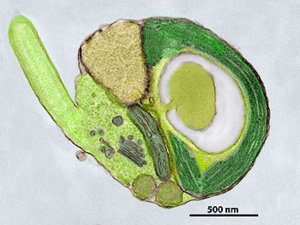
Micromonas — cross-section image by T. Deerinck et al. (National Center for Microscopy and Imaging Research) and A.Z. Worden (MBARI). |
Horizontal gene transfer (HGT) was once thought to be virtually impossible. Now however, it is recognized as the main driver of evolution among prokaryotes. This paradigm shift should be unsettling for darwinism, because the genes that bacteria acquire by HGT generally lack observable "origins". They come from somewhere else, already formed. If they were gradually composed in the darwinian manner, clear evidence for that process should be accumulating. It isn't.
Still, darwinists maintain that HGT is of minor importance among eukaryotes. But important examples have now been documented too often to keep count. The studied marine algae simply add to the evidence that HGT is crucial for eukaryotic evolution as well.
As genomic databases grow, darwinists expect the number of genes without known orthologs to decrease. This is not happening. Also, darwinists expect genes for given features to be found only in organisms that exhibit those features. Otherwise, the unnecessary genes would lack the pressure of natural selection and degrade. Moreover, they would never have had the benefit of natural selection to help them form in the first place. Yet many examples of such unnecessary genes have been documented. The recent analysis adds to that list.
In cosmic ancestry, all genes are very old. They would naturally be sometimes found in species that don't use them. Among eukaryotes, processes like gene conversion may help to preserve the silent genes from degradation. By HGT, species that can use them may eventually acquire the genes, and an evolutionary advance may ensue. We think the evidence supports this scenario. The recent analysis of marine algae does not surprise us.
 Alexandra Z. Worden et al., "Green Evolution and Dynamic Adaptations Revealed by Genomes of the Marine Picoeukaryotes Micromonas," doi:10.1126/science.1167222, p 268-272 v 324, Science, 10 Apr 2009. Alexandra Z. Worden et al., "Green Evolution and Dynamic Adaptations Revealed by Genomes of the Marine Picoeukaryotes Micromonas," doi:10.1126/science.1167222, p 268-272 v 324, Science, 10 Apr 2009.
 John M. Archibald, "Green Evolution, Green Revolution," doi:10.1126/science.1172972, p 191-192 v 324, Science, 10 Apr 2009. John M. Archibald, "Green Evolution, Green Revolution," doi:10.1126/science.1172972, p 191-192 v 324, Science, 10 Apr 2009.
 Genes from tiny marine algae suggest unsuspected avenues for new research by Kim Fulton-Bennett, Monterey Bay Aquarium Research Institute, 9 Apr 2009. "A microscopic alga with leaves?" Genes from tiny marine algae suggest unsuspected avenues for new research by Kim Fulton-Bennett, Monterey Bay Aquarium Research Institute, 9 Apr 2009. "A microscopic alga with leaves?"
 Viruses and Other Gene Transfer Mechanisms is the main related webpage [ Viruses and Other Gene Transfer Mechanisms is the main related webpage [ What'sNEW about HGT What'sNEW about HGT  ] ]
 Why Sexual Reproduction? is a related webpage with a discussion of gene conversion. Why Sexual Reproduction? is a related webpage with a discussion of gene conversion.
 Thanks, Hans-Peter Wheeler. Thanks, Hans-Peter Wheeler.

 7 April 2009 7 April 2009
Life could spread from planet to planet or from stellar system to stellar system, carried on meteors — Stephen Hawking, April 2009. Hawking is one of several celebrity-scientist who have recently endorsed panspermia.
 Ruminations on other worlds: Stephen Hawking's daughter, Lucy Hawking, presents her father's work in a prerecorded audio and slideshow at an Origins Symposium at Arizona State University, Tempe, 3-6 Apr, reported by Rheyanne Weaver, 7 Apr 2009. Ruminations on other worlds: Stephen Hawking's daughter, Lucy Hawking, presents her father's work in a prerecorded audio and slideshow at an Origins Symposium at Arizona State University, Tempe, 3-6 Apr, reported by Rheyanne Weaver, 7 Apr 2009.
 Thanks, Google Alerts. Thanks, Google Alerts.
 Introduction: More Than Panspermia lists other panspermia endorsers, in red, under What'sNEW. Introduction: More Than Panspermia lists other panspermia endorsers, in red, under What'sNEW.
|
 More than 20% of diatom genes were apparently recruited from red and green algae. The process probably began with endosymbiosis, when the algae were engulfed as organelles within cells ancestral to diatoms, but the recruited genes are now incorporated into the diatoms' nuclear genomes. Endosymbiosis is horizontal gene transfer (HGT) in wholesale form, and the subsequent migration of organellar genes into the eukaryotic nucleus is a well known phenomenon. However, other more piecemeal forms of HGT might also account for some of the transferred genes, according to an international research team. Examples of HGT in any form are consistent with evolution by cosmic ancestry.
More than 20% of diatom genes were apparently recruited from red and green algae. The process probably began with endosymbiosis, when the algae were engulfed as organelles within cells ancestral to diatoms, but the recruited genes are now incorporated into the diatoms' nuclear genomes. Endosymbiosis is horizontal gene transfer (HGT) in wholesale form, and the subsequent migration of organellar genes into the eukaryotic nucleus is a well known phenomenon. However, other more piecemeal forms of HGT might also account for some of the transferred genes, according to an international research team. Examples of HGT in any form are consistent with evolution by cosmic ancestry. A novel bacterium that has been trapped more than three kilometres under glacial ice in Greenland for over 120,000 years, may hold clues as to what life forms might exist on other planets. This is what astrobiologists are saying about Herminiimonas glaciei, recently found and cultured by a team at Penn State. The bacteria are small enough to pass through a normal sterilizing filter, and culturing them was tedious. But could their hardiness enable them to survive on a place like Europa? These extremely cold environments are the best analogues of possible extraterrestrial habitats, said team leader Jennifer Loveland-Curtze.
A novel bacterium that has been trapped more than three kilometres under glacial ice in Greenland for over 120,000 years, may hold clues as to what life forms might exist on other planets. This is what astrobiologists are saying about Herminiimonas glaciei, recently found and cultured by a team at Penn State. The bacteria are small enough to pass through a normal sterilizing filter, and culturing them was tedious. But could their hardiness enable them to survive on a place like Europa? These extremely cold environments are the best analogues of possible extraterrestrial habitats, said team leader Jennifer Loveland-Curtze.
 Formic acid ...has been found at record levels on a meteorite that fell onto a frozen Canadian lake in 2000. The University of Alberta's meteorite curator Chris Herd (pictured with sample) reported this finding to the American Geophysical Union in Toronto in May. The Tagish Lake meteorite is an especially pristine one; organic compounds in it are unlikely to be earthly contaminants. Organics from space are usually called "prebiotic", but we think they could as well be "postbiotic".
Formic acid ...has been found at record levels on a meteorite that fell onto a frozen Canadian lake in 2000. The University of Alberta's meteorite curator Chris Herd (pictured with sample) reported this finding to the American Geophysical Union in Toronto in May. The Tagish Lake meteorite is an especially pristine one; organic compounds in it are unlikely to be earthly contaminants. Organics from space are usually called "prebiotic", but we think they could as well be "postbiotic". Astrobiologist Richard Hoover discusses his work in a new short video. In five minutes he describes extremophiles that could apparently survive in ice on Mars or Europa, and microfossils that resemble microbial life, found inside carbonaceous meteorites (see example). One microfossil in the Murchison meteorite was seen for the first time as the video was being filmed.
Astrobiologist Richard Hoover discusses his work in a new short video. In five minutes he describes extremophiles that could apparently survive in ice on Mars or Europa, and microfossils that resemble microbial life, found inside carbonaceous meteorites (see example). One microfossil in the Murchison meteorite was seen for the first time as the video was being filmed.


 In what has been called the "big bang of immunology," most vertebrates later evolved a second form of immunity, in which white blood cells exquisitely targeted to a specific pathogen are rallied and then maintained in the body as an immune memory. This "adaptive" arm seemed to have appeared out of nowhere some 450 million years ago and may be the serendipitous outcome of invading DNA introduced by a virus or microbe infecting a fishlike creature.
In what has been called the "big bang of immunology," most vertebrates later evolved a second form of immunity, in which white blood cells exquisitely targeted to a specific pathogen are rallied and then maintained in the body as an immune memory. This "adaptive" arm seemed to have appeared out of nowhere some 450 million years ago and may be the serendipitous outcome of invading DNA introduced by a virus or microbe infecting a fishlike creature.
 Rivers flowed on Mars more recently than once believed. To ascertain this a team at Brown University studied high-resolution images of the Lyot crater taken by the Mars Reconnaissance Orbiter. Although it was formed only about a billion years ago, the crater contains river channels up to 50 km long. The crater floor is 7,000 meters deep, so surface air pressure would likely have been high enough for meltwater from underground glaciers to persist in a liquid state. Liquid water would have allowed life to grow on Mars.
Rivers flowed on Mars more recently than once believed. To ascertain this a team at Brown University studied high-resolution images of the Lyot crater taken by the Mars Reconnaissance Orbiter. Although it was formed only about a billion years ago, the crater contains river channels up to 50 km long. The crater floor is 7,000 meters deep, so surface air pressure would likely have been high enough for meltwater from underground glaciers to persist in a liquid state. Liquid water would have allowed life to grow on Mars.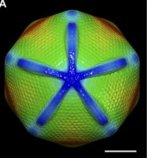
 Freeman Dyson thinks panspermia is more likely if life can adapt to the vacuum of space. In Cambridge MA on May 2, he went on to say that we should look for forms of extraterrestrial life that are easiest to find, not ones that we consider most likely to exist. For example, plant-like life on the surface of a dimly lit planet or moon would need a light-concentrating aparatus such as a parabolic mirror or a lens. Such life would shine brightly when viewed from the direction of its source, like a deer's eyes in the headlights, suggested Dyson (pictured, center).
Freeman Dyson thinks panspermia is more likely if life can adapt to the vacuum of space. In Cambridge MA on May 2, he went on to say that we should look for forms of extraterrestrial life that are easiest to find, not ones that we consider most likely to exist. For example, plant-like life on the surface of a dimly lit planet or moon would need a light-concentrating aparatus such as a parabolic mirror or a lens. Such life would shine brightly when viewed from the direction of its source, like a deer's eyes in the headlights, suggested Dyson (pictured, center).
 In their Metabolism-First scenario a simplified version of the Krebs cycle originally ran backward, using carbon dioxide and hydrogen to produce water and acetate (right). They believe that this cycle could arise naturally, and could acquire "further elaborations" enabling it to produce more complex organic molecules. Hopefully, a way to exclude the harmful byproducts will become apparent, they note. Later the system could come under the control of RNA molecules and begin to resemble life as we know it. They suggest that, this way, "the early stages in the emergence of life are no more surprising, no more accidental, than water flowing downhill."
In their Metabolism-First scenario a simplified version of the Krebs cycle originally ran backward, using carbon dioxide and hydrogen to produce water and acetate (right). They believe that this cycle could arise naturally, and could acquire "further elaborations" enabling it to produce more complex organic molecules. Hopefully, a way to exclude the harmful byproducts will become apparent, they note. Later the system could come under the control of RNA molecules and begin to resemble life as we know it. They suggest that, this way, "the early stages in the emergence of life are no more surprising, no more accidental, than water flowing downhill."


 Two new complex organic molecules have been seen toward the center of our galaxy. Ethyl formate (right) and n-propyl cyanide were detected by astronomers analysing spectra gathered at the 30-meter IRAM telescope in southern Spain.
Two new complex organic molecules have been seen toward the center of our galaxy. Ethyl formate (right) and n-propyl cyanide were detected by astronomers analysing spectra gathered at the 30-meter IRAM telescope in southern Spain. Microbial life trapped in darkness under ice accounts for the "Blood Falls" at the snout of Taylor Glacier in Antarctica. An international interdisciplinary team shows that the staining brine leaks from a hidden pool of iron-rich, oxygen-poor, hyper-saline seawater. The pool was trapped some 1.5 to 4 million years ago when the glacier closed over it. To account for the chemicals and isotope ratios observed in the discharge, the team proposes that a metabolically active ecosystem, with microbes converting ferric iron to ferrous iron, creates food and energy in the pool. When the brine episodically leaks onto the surface 4 km away, the ferrous iron "rusts" and turns red.
Microbial life trapped in darkness under ice accounts for the "Blood Falls" at the snout of Taylor Glacier in Antarctica. An international interdisciplinary team shows that the staining brine leaks from a hidden pool of iron-rich, oxygen-poor, hyper-saline seawater. The pool was trapped some 1.5 to 4 million years ago when the glacier closed over it. To account for the chemicals and isotope ratios observed in the discharge, the team proposes that a metabolically active ecosystem, with microbes converting ferric iron to ferrous iron, creates food and energy in the pool. When the brine episodically leaks onto the surface 4 km away, the ferrous iron "rusts" and turns red.

